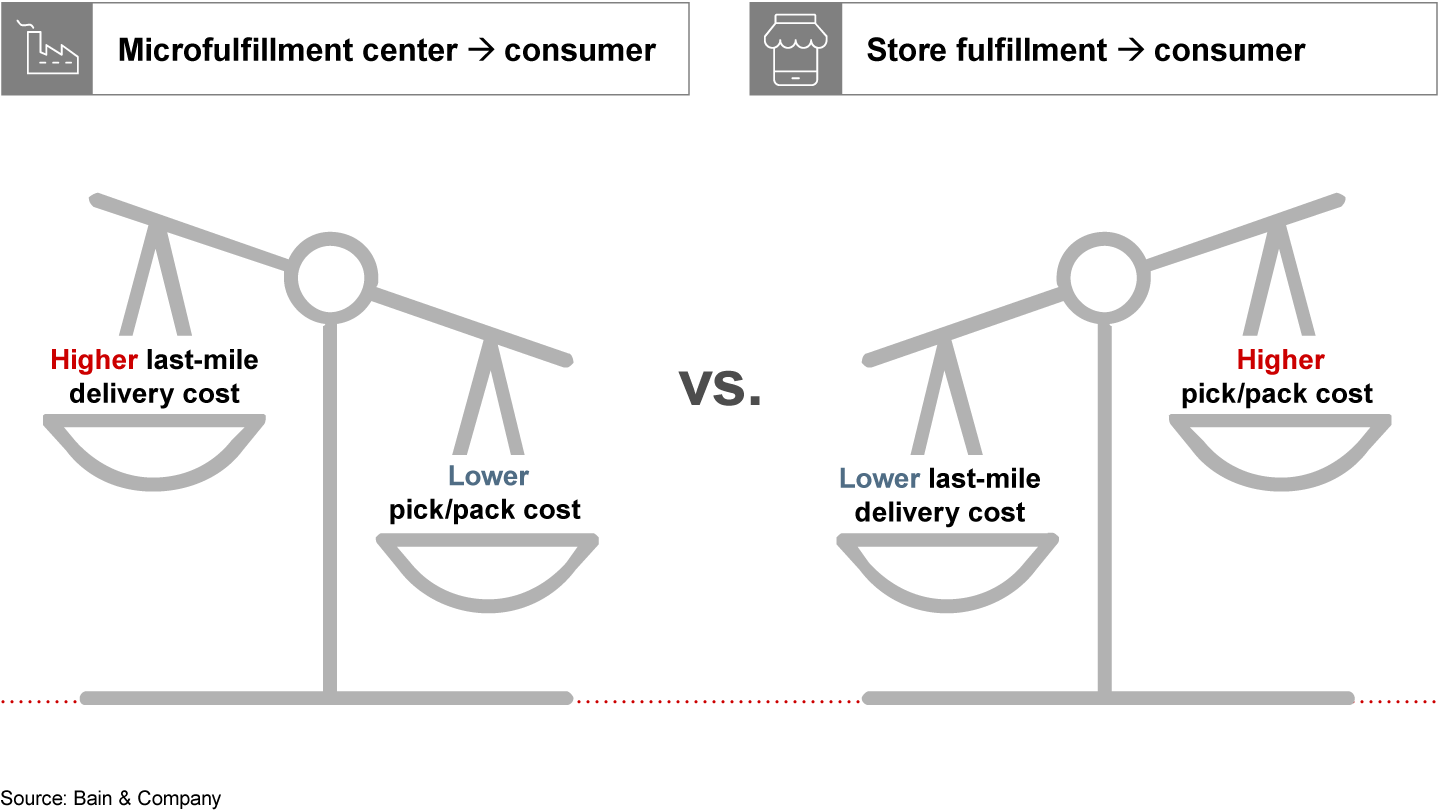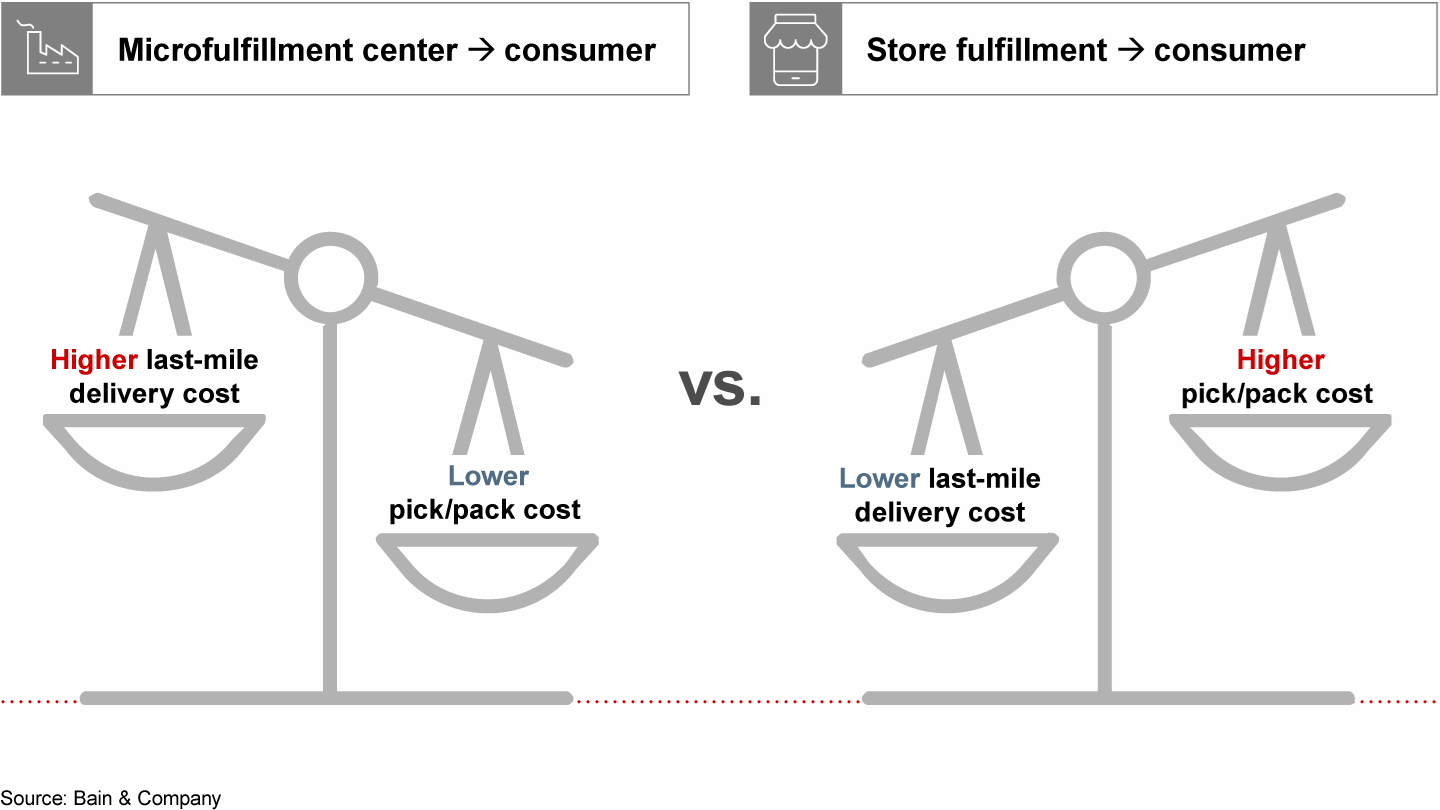Article

Covid-19 has triggered unprecedented growth in e-commerce, overwhelming retailers’ supply chains. Between March and September 2020, US online orders at Walmart more than tripled to 20% of sales; at Best Buy, they more than doubled to 50%. And online grocery sales doubled in 2020 in both the US and some European countries.
The e-commerce surge is straining global distribution systems just as digital pioneers like Amazon raise customer expectations on speed of delivery to one day or less. And the biggest challenge is yet to come: Bain research shows that US retail e-commerce penetration will grow to nearly 30% of total sales by 2025.
Retail executives are feeling the pain. A sharp rise in online sales has magnified the problems of aging distribution networks, including inventory pileups, slow cycle times and supply in the wrong place. As a result, executives are struggling from week to week to increase network speed, boost flexibility and keep costs down. It’s the ultimate supply chain balancing act.
“How can we meet growing customer demands now, without a massive investment in new distribution facilities?” We hear this all the time. The good news is that you can design your long-term strategy with thoughtful capital outlays while immediately improving supply chain performance using the infrastructure you have in place. Many retailers have an asset that Amazon does not—a vast network of stores.
Successful retailers optimize network efficiency, speed and flexibility by determining what matters most to their customers. That allows them to make better use of their existing supply nodes—distribution centers, microfulfillment centers, hub stores and individual stores—to meet the most pressing need first. It also enables them to rapidly improve customer satisfaction without rushing into a huge capital investment. Retailers that rank convenience and fast delivery as top priorities, for example, could rely more on their own stores for e-commerce fulfillment. Those that care most about efficiency will use distribution centers or microfulfillment centers.
In our experience, many retailers can achieve gains in all three categories—cost, speed and flexibility—by tackling basic inefficiencies in omnichannel fulfillment. For example, a US specialty retailer, with a supply chain designed to minimize cost, is on track to double its same-day and next-day delivery capacity, turning its network into a competitive weapon. The shift to a store-centric fulfillment model will increase fulfillment speed and avert a large capital investment—the forecast increase in operating costs is less than 1%.
The battle of the nodes
Retailers were already grappling with rapid change before Covid-19 struck, but the pandemic has accelerated e-commerce penetration by one to two years. To meet growing online demand, many retailers are rushing to build microfulfillment centers that push fulfillment closer to the end customer but still offer the benefits of a centralized facility and operations. Sometimes that’s the right choice. However, many retailers can fulfill e-commerce orders efficiently from their existing stores, cutting down the high cost of last-mile delivery.
One of Target’s early digital moves was to offer customers the option of buying online and picking up their purchases in stores. Now, the retailer is increasingly relying on ship-from-store, which it has determined is cheaper, in many instances, than shipping from a microfulfillment center. Target is also experimenting with fulfilling e-commerce orders from a sorting center, sending purchases from the store closest to the customer to a nearby center to be packaged and shipped for last-mile delivery.
Retailers with vast store networks, such as Best Buy, are scaling the store-fulfillment strategy by delegating hub stores with extra capacity to fulfill digital orders. Of course, microfulfillment centers and traditional distribution centers are more efficient: Their labor costs are lower and they require less inventory—as long as they can deliver goods in a timely manner. But as customer expectations for rapid delivery continue to rise, many retailers are starting to rely to some degree on in-store fulfillment.
Priority on speed. Retailers that offer to deliver orders on the same day or the next day can improve speed and responsiveness by shipping the majority of goods from existing stores. The approach is especially well suited to larger stores that can accommodate in-house fulfillment workers, either picking goods from the floor or from a separate platform in the back of the store. Walmart uses the same approach in China, and it relies on a partner to offer one-hour grocery delivery within a limited radius. In-store fulfillment reduces the cost of the last mile of delivery, but it also results in a greater number of split shipments and increased inventory stock. So, retailers that choose this option require more accurate demand forecasting by fulfillment location.
Almost every retailer is struggling to minimize split shipments while still enabling fast delivery. And some already are improvising on the in-store fulfillment model. Target began experimenting with sending goods from stores to a sorting center for packing and shipping, in part to help reduce split shipments.
Priority on efficiency. Retailers that put cost efficiency first use a heavier mix of centralized e-commerce fulfillment centers in their network model design, including microfulfillment centers. Centralized fulfillment is more productive when it comes to picking and packing units per hour. That gain helps offset the increased delivery cost of shipping from a more distant supply (see Figure 1). The risk: If picking and packing efficiencies in a centralized fulfillment model don’t offset higher delivery cost—and consumer expectations for rapid delivery continue to rise—this strategy may result in a competitive disadvantage.
Leading retailers weigh delivery cost with picking and packing efficiency across all distribution nodes


Kroger has taken an efficiency-first approach in its partnership with British grocer Ocado: It licensed Ocado’s automated warehouse technology, which is designed to fulfill online orders for delivery to consumers’ doors.
Many European retailers are also relying more on distribution centers or microfulfillment centers, as stores are not always large enough to accommodate e-commerce picker capacity. For instance, Carrefour in Qatar announced in 2020 that it will open another fulfillment center to serve the spike in online demand. Waitrose opened a six-acre fulfillment center in north London in May, doubling its capacity to fulfill online orders, and plans to open a third fulfillment center, located in west London.
Priority on flexibility. The world has become more volatile and less predictable. No retailer can forecast exactly how e-commerce will develop. And a range of external forces from weather to geopolitics can suddenly disrupt global supply chains. A flexible fulfillment strategy will help companies adjust rapidly to unexpected shifts in supply and demand.
For instance, when Covid-19 reduced store traffic, some European retailers quickly increased their reliance on ship-from-store as the number of customers shopping in-store declined, opening up space for fulfillment employees on the floor. Having this flexibility gave these retailers a competitive edge.
Successful retailers have a clear customer-first vision that helps determine the right priority when it comes to fulfillment, be it speed, efficiency or flexibility.
The authors would like to thank Sara Katherine Padilla for her contributions to this article.